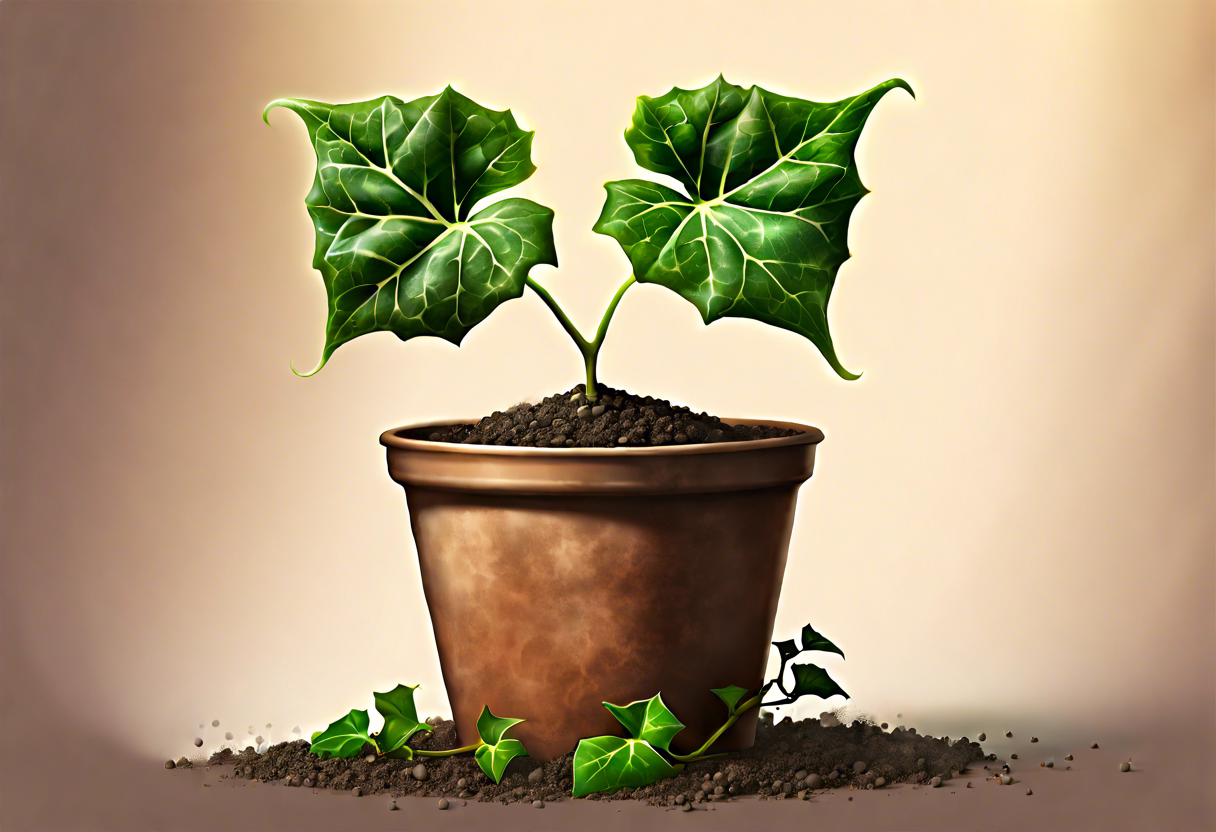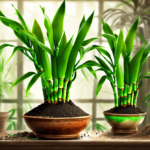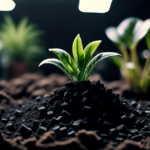Understanding the Specific Soil Requirements of English Ivy (Hedera helix)
English Ivy (Hedera helix) is a popular and versatile plant known for its ability to thrive in a variety of conditions. However, to ensure optimal growth and health, it is important to choose the right soil or potting mix. The soil requirements of English Ivy are unique, and understanding them will help you provide the best growing environment for this beautiful plant.
When it comes to soil type, English Ivy prefers a well-drained soil that is rich in organic matter. A loamy soil with a slightly acidic to neutral pH (around 6.0 to 7.0) is ideal for this plant. Loamy soil offers the perfect balance of water retention and drainage, ensuring that the roots of the English Ivy do not become waterlogged. It also provides enough nutrients for healthy growth.
Before planting English Ivy, it is important to prepare the soil properly. Start by removing any weeds or unwanted plants from the area. Loosen the soil using a garden fork or tiller to improve its drainage. Incorporate organic matter, such as compost or well-rotted manure, into the soil to improve its fertility and structure.
When it comes to potting mix, using a commercial potting mix specifically formulated for houseplants or container gardening is a great option. These mixes are typically well-draining and contain a balanced combination of peat moss, perlite, and vermiculite. They also contain essential nutrients that can support the growth and development of English Ivy.
While English Ivy can tolerate a wide range of soil conditions, it is important to avoid heavy clay soils or waterlogged conditions. These can lead to root rot and other problems that can affect the overall health of the plant. Additionally, sandy soils that drain too quickly may require more frequent watering and fertilization to ensure the plant’s nutritional needs are met.
The best soil or potting mix for English Ivy (Hedera helix) is a well-drained loamy soil with a slightly acidic to neutral pH. organic matter into the soil will improve its fertility and structure, providing essential nutrients for healthy growth. When using a potting mix, choose a commercial mix designed for houseplants or container gardening. Avoid heavy clay soils and waterlogged conditions, as well as sandy soils that drain too quickly. By understanding and meeting the specific soil requirements of English Ivy, you can ensure its success and enjoy its lush foliage for years to come.
Comparing Different Soil Types for English Ivy Growth
English Ivy (Hedera helix) is a popular and versatile plant that can thrive both indoors and outdoors. However, to ensure optimal growth and health, it is essential to provide it with the right soil type. Different soil types have distinct characteristics that can greatly influence the development of English Ivy. In this article, we will explore some of the best soil types for English Ivy growth, allowing you to choose the most suitable option for your plant.
Firstly, it’s important to note that English Ivy prefers a well-draining soil. This means that the soil should not retain excessive moisture, which can lead to root rot and other fungal diseases. Sandy loam is an excellent soil type for English Ivy since it promotes good drainage while also retaining enough moisture for the plant’s needs. Sandy loam is characterized by a balanced mixture of sand, silt, and clay, creating a soil structure that allows for proper water movement.
In addition to good drainage, English Ivy also benefits from a slightly acidic to neutral pH level. A pH range between 6 and 7 is considered ideal for this plant. You can test the pH level of your soil using a simple pH testing kit available at most gardening stores. If your soil is too acidic (below pH 6) or too alkaline (above pH 7), you can make adjustments by adding organic matter, such as compost or peat moss, to the soil. These amendments can help balance the pH level and create a more suitable growing environment for English Ivy.
Furthermore, English Ivy appreciates a nutrient-rich soil that can support its vigorous growth. organic matter into the soil, such as compost or well-rotted manure, can provide essential nutrients and improve soil structure. Organic matter also assists in moisture retention and enhances microbial activity, benefiting the overall health of the plant. Additionally, slow-release fertilizers formulated for indoor plants or general-purpose fertilizers can be applied to supplement the soil’s nutrient content.
When considering potting mix options for English Ivy, it is recommended to use a high-quality commercial potting mix or create a custom mix using equal parts of peat moss, perlite, and vermiculite. This combination creates a well-aerated and well-draining medium that supports root growth and prevents waterlogging. Adding a layer of small stones or pebbles at the bottom of the pot can further enhance drainage.
The best soil type for English Ivy growth is a well-draining sandy loam with a slightly acidic to neutral pH level. By incorporating organic matter and using a high-quality potting mix, you can create an optimal growing environment for this versatile plant. Remember to regularly monitor the moisture levels and adjust watering accordingly to ensure the health and vitality of your English Ivy. With the right soil, your English Ivy will thrive and bring beauty to any space it graces.
Understanding the Importance of a Well-Drained Potting Mix for English Ivy
When it comes to growing English Ivy (Hedera helix) indoors, one of the key factors that can greatly impact its health and growth is the choice of soil or potting mix. English Ivy is a versatile and resilient plant that can thrive in a variety of conditions, but it does have specific soil requirements that need to be met for optimal growth. In this article, we will explore the importance of using a well-drained potting mix for English Ivy and how it can contribute to the overall health of the plant.
English Ivy is a plant that prefers slightly acidic to neutral soil pH, ranging from 6.0 to 7.5. It is important to choose a potting mix that is formulated to meet these requirements. A well-drained potting mix allows excess water to drain away quickly, preventing the roots from sitting in soggy soil. This is crucial for preventing root rot and other moisture-related issues that can occur when the soil becomes waterlogged. A potting mix with good drainage also helps to ensure that the roots have access to oxygen, which is essential for their health and proper function.
In addition to good drainage, a quality potting mix for English Ivy should also be lightweight and have the ability to retain some moisture. This balance is important to provide the plant with adequate hydration without risking overwatering. Look for a potting mix that contains a combination of materials such as peat moss, perlite, vermiculite, and/or compost. These ingredients promote both drainage and moisture retention, creating an ideal environment for the roots to thrive.
When it comes to choosing between organic and synthetic potting mixes, both options can be suitable for English Ivy, depending on personal preference and availability. Organic potting mixes are made from natural materials and are generally free from synthetic additives and chemicals. They can provide a more sustainable and eco-friendly choice, especially for those who prioritize organic gardening. Synthetic potting mixes, on the other hand, are often formulated with a blend of inorganic materials such as sand and expanded clay pellets. They tend to have a longer lifespan and can offer better control over moisture levels. Ultimately, the choice between organic and synthetic potting mixes for English Ivy comes down to personal preference and individual growing conditions.
Selecting a well-drained potting mix is crucial for the successful cultivation of English Ivy. It should provide proper drainage, lightweight texture, and adequate moisture retention capabilities. Whether you opt for organic or synthetic potting mixes, ensure that they meet the specific soil requirements of English Ivy. By providing the right environment for your English Ivy, you can encourage healthy growth and enjoy the beauty of this versatile plant in your indoor space.
Best Fertilizers for English Ivy (Hedera helix) – Organic Vs. Synthetic
Fertilizers play a crucial role in providing essential nutrients to plants, including English Ivy (Hedera helix). Whether to choose organic or synthetic fertilizers is a common dilemma amongst gardeners. Each type has its advantages and disadvantages. Here, we will discuss the benefits and drawbacks of both, helping you decide which is the best option for nourishing your English Ivy.
Organic Fertilizers:
Organic fertilizers are derived from natural materials, such as plant and animal waste, and contain a wide range of nutrients. They release nutrients slowly, ensuring a steady supply for plant growth. Additionally, they improve soil structure, promote microbial activity, and enhance water-holding capacity, which benefits the overall health of English Ivy.
One of the primary advantages of organic fertilizers is their environmental friendliness. They are non-toxic and do not introduce harmful chemicals to the ecosystem. Furthermore, organic fertilizers improve soil fertility in the long term, as they enhance the soil’s organic matter content.
However, organic fertilizers have a few drawbacks. They release nutrients slowly, which means the results may not be immediate. Patience is required when using organic fertilizers, as it takes time for the nutrients to reach the plant roots. Additionally, their nutrient composition may vary depending on the source, leading to inconsistent nutrient availability.
Synthetic Fertilizers:
Synthetic fertilizers, also known as inorganic or chemical fertilizers, are manufactured using artificial compounds. They provide a precise blend of nutrients that can be quickly absorbed by plants. Synthetic fertilizers are readily available in garden centers and are easy to use.
One of the main advantages of synthetic fertilizers is their rapid response. They deliver nutrients to the plants almost immediately, resulting in fast growth and development. Additionally, synthetic fertilizers can be formulated to cater to specific nutrient requirements of English Ivy.
However, synthetic fertilizers have some drawbacks. Over-reliance on synthetic fertilizers can lead to nutrient imbalances and the depletion of beneficial soil microorganisms. Moreover, excessive use of synthetic fertilizers can result in water pollution if not used correctly.
:
When choosing between organic and synthetic fertilizers for English Ivy, it is important to consider the specific needs of your plants, as well as your gardening practices. Organic fertilizers are wildlife-friendly, improve soil fertility, and have long-term benefits. Synthetic fertilizers, on the other hand, provide quick results and can be tailored to specific nutrient requirements.
To strike a balance, many gardeners choose a combination of both types. This allows for the gradual release of nutrients from organic fertilizers, along with the immediate availability of nutrients from synthetic fertilizers. Regular soil testing can also help determine the nutrient composition and deficiencies in the soil, guiding a more targeted approach to fertilization.
Remember, always follow the recommended application rates, as over-fertilization can harm your English Ivy. With proper fertilization, your English Ivy will thrive, exhibiting lush foliage and becoming a stunning addition to your indoor or outdoor space.
Tips for Successful Transplanting: Choosing the Right Potting Mix for English Ivy
Transplanting English Ivy (Hedera helix) can be an exciting endeavor for both experienced gardeners and beginners. Whether you are looking to propagate new plants or simply relocate existing ones, choosing the right potting mix is crucial for the success of your English Ivy transplant. In this article, we will explore the key factors to consider when selecting the best soil or potting mix for English Ivy.
1. Well-Drained Soil: English Ivy thrives in well-drained soil that is not overly soggy. When transplanting, opt for a potting mix that provides excellent drainage to prevent the roots from becoming waterlogged. A lightweight potting mix made with a combination of peat moss, perlite, and vermiculite is often ideal for English Ivy.
2. Rich and Nutrient-Dense: English Ivy benefits from a nutrient-rich potting mix that can support its growth. Look for a mix that contains organic matter such as compost or well-rotted manure. These organic components release essential nutrients slowly, providing a steady supply for the plant.
3. pH Balance: English Ivy prefers slightly acidic to neutral soil with a pH range of 6 to 7. Avoid potting mixes that are too alkaline, as this can affect the plant’s ability to absorb nutrients effectively. Consider using a pH meter or test kit to ensure the potting mix is within the desired range.
4. Good Aeration: Adequate air circulation is essential for healthy root development in English Ivy. Choose a potting mix that is loose and well-aerated, allowing oxygen to reach the roots. This will prevent the soil from compacting and promote robust growth.
5. Sterility: When transplanting English Ivy, it is crucial to minimize the risk of introducing pests and diseases. Opt for a potting mix that is sterile or has been pasteurized to eliminate any potential pathogens. This will help protect the health of your Ivy plants and prevent the spread of unwanted pests.
6. Moisture Retention: While English Ivy prefers well-drained soil, it still requires consistent moisture. Look for a potting mix that can retain moisture without becoming waterlogged. This balance is crucial to prevent the Ivy from drying out or suffocating its roots.
Remember, each plant has unique requirements, so it is essential to observe your English Ivy’s specific needs. Regularly monitor moisture levels, and adjust watering accordingly. Additionally, be mindful of the pot size when transplanting to accommodate the Ivy’s spreading habit and allow sufficient room for root growth.
Choosing the right potting mix is the first step towards successful transplanting of English Ivy. By providing a well-drained, nutrient-rich, and pH-balanced environment, you can ensure the optimal growth and health of your Ivy plants. Take your time to research and select the best potting mix available, and your English Ivy will reward you with lush foliage and vigorous growth.
Conclusion
It is vital to understand the specific soil requirements of English Ivy (Hedera helix) in order to ensure its optimal growth. English Ivy thrives in well-drained soil that is rich in organic matter. The best soil for English Ivy is a balanced mix of loam, peat moss, and perlite or vermiculite to improve drainage and aeration.
When comparing different soil types for English Ivy growth, it is clear that a loamy soil with good drainage is preferred. Loam provides a balanced texture that allows for both water retention and proper drainage. It also contains essential nutrients that support the healthy growth of English Ivy. Avoid heavy clay soils that can become waterlogged or sandy soils that lack adequate moisture retention.
One of the most important considerations when selecting a potting mix for English Ivy is the ability of the soil to drain well. English Ivy does not tolerate soggy conditions, as excessive water can lead to root rot and other diseases. A well-drained potting mix allows excess water to escape, preventing waterlogging and ensuring the roots have access to oxygen.
Choosing between organic and synthetic fertilizers for English Ivy requires careful consideration. While both types can provide essential nutrients, organic fertilizers are generally more beneficial for the long-term health of the plant. Organic fertilizers release nutrients slowly, promoting steady growth and reducing the risk of nutrient burn. They also contribute to the overall health of the soil by improving its structure and promoting beneficial microbial activity.
Tips for successful transplanting include selecting the right potting mix for English Ivy. When transplanting English Ivy, choose a well-draining potting mix that is similar in composition to the original soil it was grown in. This will minimize stress on the plant and aid in the establishment of new roots. Additionally, adding a layer of organic mulch on top of the soil can help retain moisture and regulate temperature, further promoting healthy growth.
To sum up, the best soil or potting mix for English Ivy is one that provides good drainage, is rich in organic matter, and offers a balanced texture. Loam, peat moss, and perlite or vermiculite are ideal components that meet these requirements. Choosing organic fertilizers and following proper transplanting techniques will also contribute to the overall success of growing English Ivy (Hedera helix). By understanding and meeting the specific soil needs of English Ivy, gardeners can enjoy lush, thriving plants that enhance their indoor or outdoor spaces.


